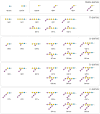Simulating the enzymes of ganglioside biosynthesis with Glycologue
- PMID: 33828618
- PMCID: PMC8008095
- DOI: 10.3762/bjoc.17.64
Simulating the enzymes of ganglioside biosynthesis with Glycologue
Abstract
Gangliosides are an important class of sialylated glycosphingolipids linked to ceramide that are a component of the mammalian cell surface, especially those of the central nervous system, where they function in intercellular recognition and communication. We describe an in silico method for determining the metabolic pathways leading to the most common gangliosides, based on the known enzymes of their biosynthesis. A network of 41 glycolipids is produced by the actions of the 10 enzymes included in the model. The different ganglioside nomenclature systems in common use are compared and a systematic variant of the widely used Svennerholm nomenclature is described. Knockouts of specific enzyme activities are used to simulate congenital defects in ganglioside biosynthesis, and altered ganglioside status in cancer, and the effects on network structure are predicted. The simulator is available at the Glycologue website, https://glycologue.org/.
Keywords: Glycologue; Svennerholm nomenclature; gangliosides; glycosyltransferases; neuropathy.
Copyright © 2021, McDonald and Davey.
Figures





Similar articles
-
O-Glycologue: A Formal-Language-Based Generator of O-Glycosylation Networks.Methods Mol Biol. 2022;2370:223-236. doi: 10.1007/978-1-0716-1685-7_11. Methods Mol Biol. 2022. PMID: 34611872
-
Golgi localization of glycosyltransferases involved in ganglioside biosynthesis.Curr Drug Targets. 2008 Apr;9(4):282-91. doi: 10.2174/138945008783954989. Curr Drug Targets. 2008. PMID: 18393822 Review.
-
Current state-of-the-art on ganglioside-mediated immune modulation in the tumor microenvironment.Cancer Metastasis Rev. 2023 Sep;42(3):941-958. doi: 10.1007/s10555-023-10108-z. Epub 2023 Jun 2. Cancer Metastasis Rev. 2023. PMID: 37266839 Free PMC article. Review.
-
Structural analysis of brain ganglioside acetylation patterns in mice with altered ganglioside biosynthesis.Carbohydr Res. 2013 Dec 15;382:1-8. doi: 10.1016/j.carres.2013.09.007. Epub 2013 Sep 27. Carbohydr Res. 2013. PMID: 24140892
-
Regulation of ganglioside biosynthesis in the nervous system.J Lipid Res. 2004 May;45(5):783-93. doi: 10.1194/jlr.R300020-JLR200. J Lipid Res. 2004. PMID: 15087476 Review.
Cited by
-
Simulated digestions of free oligosaccharides and mucin-type O-glycans reveal a potential role for Clostridium perfringens.Sci Rep. 2024 Jan 18;14(1):1649. doi: 10.1038/s41598-023-51012-4. Sci Rep. 2024. PMID: 38238389 Free PMC article.
-
In silico simulation of glycosylation and related pathways.Anal Bioanal Chem. 2024 Jul;416(16):3687-3696. doi: 10.1007/s00216-024-05331-8. Epub 2024 May 15. Anal Bioanal Chem. 2024. PMID: 38748247 Free PMC article. Review.
-
GlycoBioinformatics.Beilstein J Org Chem. 2021 Nov 9;17:2726-2728. doi: 10.3762/bjoc.17.184. eCollection 2021. Beilstein J Org Chem. 2021. PMID: 34858527 Free PMC article. No abstract available.
-
In silico analysis of the human milk oligosaccharide glycome reveals key enzymes of their biosynthesis.Sci Rep. 2022 Jun 27;12(1):10846. doi: 10.1038/s41598-022-14260-4. Sci Rep. 2022. PMID: 35760821 Free PMC article.
References
LinkOut - more resources
Full Text Sources
Other Literature Sources
